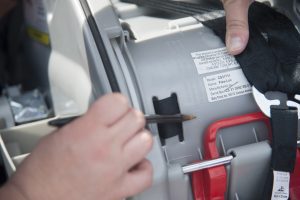Car seat expiration is a crucial aspect of child safety. Over time, exposure to changing temperatures and wear and tear can compromise the integrity of a car seat. Staying informed about expiry dates and adhering to manufacturer guidelines is vital to ensure the ongoing safety of children during travel. Let’s talk more about the facts of expired car seats.

Car seats are already very commonly used by people all over the globe because of their broader significance. It is meant to temper the impacts of a collision or crash by helping the body to slow down, thereby protecting your child’s head, the brain, and the spinal column–car seats are no wonder undeniably important to ensure the safety, security, and health of your precious cargo. There are car seat safety standards, like several crash tests, that car seat manufacturers have to adhere to. But, there are also guidelines for parents to follow when it comes to the use of car seats, convertible car seats, and even car seat expiration. The seats that are part of travel systems will also have expiration dates, along with the bases you install in your vehicle.
Expiration Dates Of Car Seats
According to research, child restraints reduce the risk of fatal injuries by 70 to 80 percent, while booster seats minimize the risk of non-fatal injuries by 45 percent relative to just seat belts. But how long is a car seat suitable for? As with all good things come to an end, car seats do expire after some time. Parents must know what their car seat expiration dates are, and that when the seat expires they no longer use it.
Car Seat Expiration Facts
The car seat expiration referred to in your seat’s safety information is real, and here are seven facts you need to know about how long car seats are suitable for:

Yes, It’s Not A Market Strategy.
Do child car seats have a designated life span? Most people tend to think that the concept of car seat expiration is just a strategy of car seat manufacturers and distributors to compel their customers somehow to change their car seats after some time, as this would translate to sales. The reality is that car seats have a designated lifespan, and the need to replace them is a significant safety concern. The designated lifespan of a child’s seat is in place to facilitate updates with new safety features. Details about the end date can be found in your car seat’s safety information.
Also, the materials that your car seat is made of will start to break down, causing them to not function the way they’re supposed to. An expired car seat can be a very dangerous piece of baby gear because it won’t serve as side impact protection the way that it should. It’s important to note that an outdated seat may not provide adequate protection in the event of a moderate or severe crash. The American Academy of Pediatrics heavily cautions against using a car seat beyond its expiry date.
Car Seats Last For About Six Years From The Manufacturing Date.
If you want to know how long are car seats good for, it depends on the brand because the duration varies slightly. One thing is for sure: it is commonly about six years. This is true for the following brands: Britax, Chicco, Cosco, Evenflo, and Recaro. Meanwhile, for Diono, Evenflo Symphony, and Safety 1st, though, it could last two more years. But the longest may have been for Evenflo SafeMax, Graco, and Maxi-Cosi, which can go for around ten years.
- You should be able to find the car seat’s manufacture date printed on the bottom of an infant car seat or convertible car seat.
- You’ll then just add the six years, or the appropriate length of time, to that date to find the car seat expiration date.
- Don’t forget that the bases that are part of travel systems will also have an expiry date. This will give you a sense of relief, knowing that you will be using a valid car seat.
Car Seat Manufacturer Marks The Expiration Dates For Easy Identification.
Car seats are not subject to any government regulation mandating an expiry date. Instead, manufacturers establish expiry dates guided by general principles. If you want to determine when seats reach the end of their lifespan, check for stickers as these are the familiar places to find expiration dates. It could be located somewhere around the back of the car seat, at the bottom, or under the fabric padding. Some end dates are specified on the seats themselves. Better take note of these the moment you purchase them. Knowing what the expiry date is will keep you from inadvertently putting your baby in an outdated seat. This is part of the safety information you should keep in mind throughout the use of the seat.

Car Seats Deteriorate Through Continuous Use Over Time.
The base of most car seats is plastic, and seats are exposed to quick temperature changes even though they stay inside the car. That is one of the reasons why seats, even the best car seat models, have a designated lifespan. The plastic reinforced belt paths, among other components, are susceptible to the effects of temperature variations. The temperature inside could go from very cold because of the air conditioner to very hot when left outdoors during the heat of noontime. That takes a toll on plastic and causes it to weaken over time. These factors make it necessary to impose car seat expiration to ensure the best quality.
- This applies to rear-facing infant car seats, convertible car seats, and car seats that are part of travel systems, as well as the bases.
- It’s crucial to exercise diligence, especially with the use of older car seat convertible styles intended for children as they grow.
- These are meant to be used as your baby gets older, so make sure you know the car seat’s expiry date. Even an older child should not be sitting in an expired car seat.
Car Seats Can Go Obsolete After A Few Years.
Technology developments improve the capabilities of an old car seat to protect your little one better. While used car seats could be a practical option, you cannot just decide on it haphazardly. So it would always be better to double-check for the expiry date so that you won’t be using outdated car seats. Also, make sure to test the car seat for possible wear and tear. Even government agencies render old car seats obsolete over time.
You want to make sure the baby products you’re using are doing the best job at what they’re intended for. When peer-reviewed studies reveal better ways to protect our children, it’s a good idea to go with the products that have the best safety information. That might mean staying away from used car seats convertible in nature, infant car seats, and travel systems car seats. You need your seat’s features to hold up in the event that you need them to.
Better And New Car Seat Models Come Out In The Market.
Aside from the modern technologies involved in the new car seats, there are also better car seats in the market because of the innovation they bring. That means some seats may fit your vehicle better than the old one. They may be more comfortable due to a softer fabric. They may be more durable due to the materials used. They may be easier to install than the older versions.
Travel systems are very popular for families with infants and young children. These come with a stroller, an infant seat meant for rear facing, and sometimes a base that the infant car seat can just click in and out of in the car. Many families will try to keep their travel systems to use again with another baby. The strollers typically won’t have termination dates, but the rear-facing car seat and base will. Also, those pieces often get updated with newer, better features. Make sure you get these replacement parts if you’re planning to keep using your travel systems with multiple children.
Additionally, the research and safety standards conducted by the Insurance Institute for Highway Safety (IIHS) and the Highway Loss Data Institute (HLDI) play a crucial role in creating guidelines for manufacturers. These guidelines ensure that the car seat model can meet safety standards, not only in terms of crashworthiness but also in determining the appropriate lifespan of car seats.
When regulations change, there are updates in car seat regulations, focusing on safety, testing, materials, and technology, which may lead to adjustments in expiration recommendations by manufacturers. Staying informed about these changes is crucial for ensuring ongoing safety and compliance.
Car Seats Deteriorate Through Continuous Use Over Time.
First of all, it would not be best to throw your used seats in the trash. You may have to do some dismantling so that somebody would not unknowingly use it past the expiry date.
- You need to remove the foam from the expired car seat.
- Discard the car seat padding and fabric.
- Cut the expired car seat’s harness straps.
- Cut the cover seat of the car seat.
- Remove any expired car seat metal parts.
- To have an easier time, you can also bring your expired car seats to stores that offer special rebates for trade-ins.
When consulting safety information regarding outdated car seats, you’ll find detailed instructions on how to dispose of them responsibly. The recommended method involves dismantling the seat as a responsible approach.

So the next time you hear an ad about the expiration of car seats, believe them. Take the responsibility to know when a seat expires and dispose of it accordingly when the time comes. Child passenger safety does not just happen with how you use one car seat but knowing when to stop using it when it is no longer serving its purpose to protect your little ones.
FAQs:
Last Updated on April 13, 2023 by Rejie Salazar
DISCLAIMER (IMPORTANT): This information (including all text, images, audio, or other formats on FamilyHype.com) is not intended to be a substitute for informed professional advice, diagnosis, endorsement or treatment. You should not take any action or avoid taking action without consulting a qualified professional. Always seek the advice of your physician or other qualified health provider with any questions about medical conditions. Do not disregard professional medical advice or delay seeking advice or treatment because of something you have read here a FamilyHype.com.
